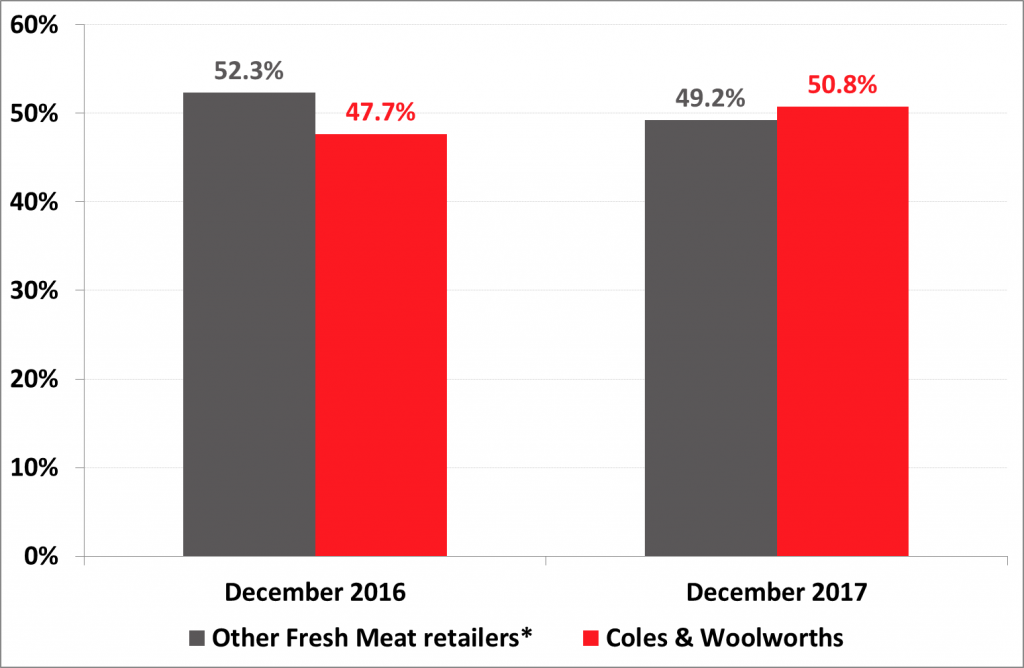It’s official: Majority of fresh meat now bought at Coles & Woolworths

Analysis of long-term market trends shows that for the first time in 2017 Australia’s two largest supermarkets captured more than 50% of Australia’s $13 billion+ fresh meat market between them.
Market leader Woolworths Group with a 26.5% share, up 1.1% points since 2016, and Coles Group with a 24.3% share, up 2% points, had a combined share of the fresh meat market larger than all other retail outlets including rival supermarkets Aldi and IGA, butchers, markets, other supermarkets and other non-supermarkets combined.
Both Australian supermarket giants have enjoyed stronger growth in the fresh meat market over the past year than rival Aldi which now has a 9.6% share of the fresh meat market, up 0.9% in a year – although all three have clearly taken substantial market share from traditional butchers.
Ten years ago butchers and markets had nearly a third (32%) of Australia’s fresh meat market. Today this is just under a quarter (24%) of the fresh meat market is now held by butchers and markets.
In the last 12 months fresh meat market share for butchers and markets dropped 3% points. This is steepest drop of any time period in the last decade.
These results are from the Roy Morgan Single Source survey of over 50,000 people per annum, including over 12,000 grocery buyers.
Australian fresh meat market 2016 v 2017

Source: Roy Morgan Single Source Australia, January 2016 – December 2016, n=8,301, January 2017 - December 2017, n=8,691. Base: Last 7 day fresh meat purchasers aged 14+ weighted to Australian households.
Michele Levine, CEO, Roy Morgan, says Australia’s increasingly competitive fresh meat market is squeezing the market share of the traditional Australian butcher:

“Australia’s ‘Big Two’ supermarket chains Woolworths and Coles now capture over 60% of Australia’s $100b+ grocery market – see analysis here. In recent years the Big Two have been moving to consolidate their market shares in various fresh food markets including fresh fruit & veg, fresh meat, fresh bread, fresh deli and fresh seafood.
“In just the past year Coles and Woolworths achieved a milestone, capturing a majority of the fresh meat market for the first time and now hold 50.8% of Australia’s fresh meat market between them. Woolworths’ fresh meat market share of Woolworths has increased 1.1% points over the past year to 26.5% while Coles has continued a decade long-trend by increasing its market share by 2% to 24.3%.
“Against the increasing concentration of the fresh meat market with the two big supermarket chains the decline in market share for butchers and markets has been consistent over the past decade. Butchers and markets held around a third of Australia’s fresh meat market in 2010 however this share has now dropped to just under a quarter.
“Unfortunately for butchers and markets, the decline in fresh meat market share appears to be accelerating with butchers and markets now holding only 24% of Australia’s fresh meat market share. This represents a decline of over 3% points over the past 12 months – the largest yearly drop in fresh meat market share for butchers and markets recorded in the past decade.
“As we’ve noted previously Australia’s supermarket duopoly has been disrupted in recent years by the arrival of Aldi which has captured a significant market share across categories and in addition to Aldi other foreign entrants are already on the lookout for supermarket locations including giant European supermarket chains Kaufland and Lidl.
“The arrival of new ‘cashed-up’ competitors keen to make a sizeable dent in Australia’s supermarket retailing landscape means the pressure on smaller specialist retailers including butchers and markets will only increase in coming years.
“However other trends identified by Roy Morgan and deeper analysis of consumer preferences shows those specialists who understand their customers are still well placed to capitalise on the ‘hidden value’ in the discretionary end of their market.
“This analysis is from the extensive Roy Morgan Supermarket & Fresh Food Currency Report which covers all food retailers, including products purchased and dollars spent. The combination of the large annual sample collected over more than a decade enables a unique in depth trend analysis of this very significant market.”
For comments or more information please contact:
Roy Morgan - Enquiries
Office: +61 (03) 9224 5309
askroymorgan@roymorgan.com
Margin of Error
The margin of error to be allowed for in any estimate depends mainly on the number of interviews on which it is based. Margin of error gives indications of the likely range within which estimates would be 95% likely to fall, expressed as the number of percentage points above or below the actual estimate. Allowance for design effects (such as stratification and weighting) should be made as appropriate.
| Sample Size | Percentage Estimate |
| 40% – 60% | 25% or 75% | 10% or 90% | 5% or 95% | |
| 1,000 | ±3.0 | ±2.7 | ±1.9 | ±1.3 |
| 5,000 | ±1.4 | ±1.2 | ±0.8 | ±0.6 |
| 7,500 | ±1.1 | ±1.0 | ±0.7 | ±0.5 |
| 10,000 | ±1.0 | ±0.9 | ±0.6 | ±0.4 |
| 20,000 | ±0.7 | ±0.6 | ±0.4 | ±0.3 |
| 50,000 | ±0.4 | ±0.4 | ±0.3 | ±0.2 |
